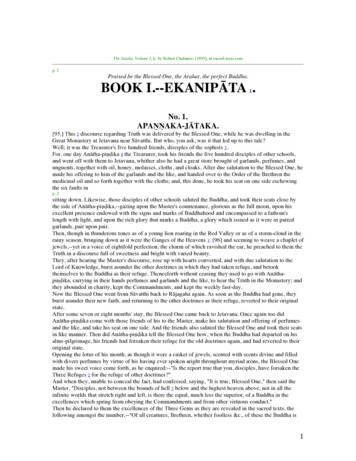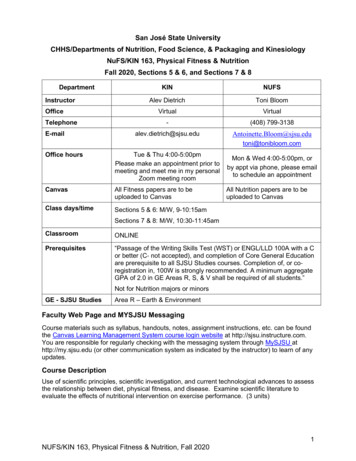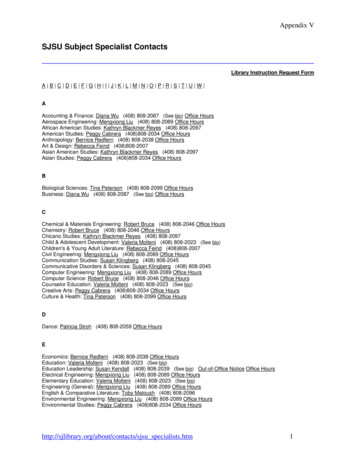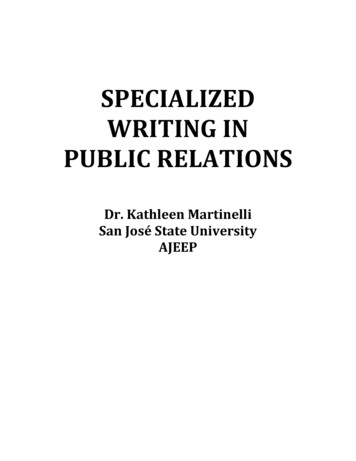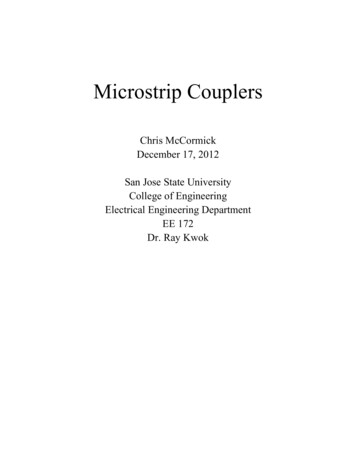
Transcription
Microstrip CouplersChris McCormickDecember 17, 2012San Jose State UniversityCollege of EngineeringElectrical Engineering DepartmentEE 172Dr. Ray Kwok
Table of Contents:Introduction2Types of Couplers2Initial Design & Simulation5Analysis8Initial Results & Corrections9Final Simulation10Results11Sources of Error12Final Remarks13References151
Appendix – Simulations & Schematics162
Introduction:Couplers are passive three or four port devices that are commonly used in RFand microwave design. In a coupler, a known percentage of power from a transmissionline is coupled to another output. Furthermore, couplers have a phase shift between thetransmitted and coupled port. This is one of the major differences between couplersand power splitters. The couplers designed and compared in this project are both fourport couplers, known as directional couplers. The two couplers compared are thebranch line and the rat-race couplers, both done with microstrip transmission lines.Each coupler has an input port, transmitted port, coupled port, and isolated port.Types of Couplers:There are dozens of different types of couplers used in just as many differentapplications. Couplers can be categorized in two main categories; waveguide couplersand microstrip couplers. Waveguide couplers usually have one or more holes betweenthem for coupling. One simple waveguide coupler is the Bethe hole coupler, whichuses one small hole to couple two waveguide transmission lines. Similarly, the multihole coupler is made of two waveguides coupled by two or more holes. Below areexamples of these waveguide couplers. The Moreno crossed-guide coupler, Riblet3
short-slot coupler, Schwinger reversed-phase coupler, and others are variants of thewaveguide couplers described above by varying the shapes and sizes of the holes aswell as the angle of the waveguide transmission lines.Figure 1: Bethe hole coupler (Pozar)4
Figure 2: Multi-hole coupler (Ishii)5
The second classification of commonly used RF couplers is the microstrip couplergroup. Two of the most common couplers that use microstrip transmission lines are thebranch line and rat-race couplers. The significance of these couplers is that they have 90degree and 180 degree phase shifts, respectively, between the transmitted port andcoupled port. The branch line and rat-race couplers are the couplers designed andcompared in this project. Their ease of fabrication and useful phase shifts made themideal choices. Both are 3 dB couplers, meaning that half of the power should be outputat the transmitted and the coupled port each. For wider bandwidths and lowercoupling, coupled line couplers are common. Examples of these are the single-sectioncoupled line coupler or the Lange coupler. These couplers use the proximity of themicrostrip transmission lines to achieve the coupling.6
Figure 3: Lange Coupler (Pozar)Initial Design & Simulation:The assignment, as it was given to me, was to compare the branch line and ratrace microstrip couplers. I knew I would use Express PCB to design and print thecircuits, so my only set specifications were the manufacturing specifications fromExpress PCB. Since the lengths of both couplers are based on wavelength, I wanted todesign the couplers for a frequency high enough to minimize my PCB area, but lowenough to be able to test with a 3 GHz network analyzer. I chose 2.4 GHz. Below arethe initial set specifications I had to work with:Cu Thickness0.0017"7
FR-4 HeightDielectric Constant0.062"4.3 to4.9Char Impedance50 ohmTable 1: Set SpecificationsFifty ohms was used for the characteristic impedance, ZO, so that no impedancematching circuits were needed between the ports and the measurement equipment.Due to the range of the dielectric constant, εr, I assumed the value to be 4.6 for myfuture calculations.Next, I calculated microstrip trace widths for the values needed in the twocouplers; .707 ZO, ZO, and 1.414 ZO. There are numerous approximation equations formicrostrip impedance calculations. I based my choices off of Equation (1), but all theequations yielded very similar answers.where εr is the dielectric constant, Zo is the characteristic impedance, W is the tracewidth, T is the copper thickness, and H is the substrate height between the groundplane and the microstrip transmission line. Solving this equation for the impedancesneeded in the two coupler designs give the following widths:Specified.707 ZoZoResistance(Ω)35.3550W (in)0.170.118
1.414 Zo70.70.061Table 2: Width CalculationsTo determine the length of each branch of the couplers, the equations below are used:where λ is the wavelength, c is the speed of light, f is the frequency, and εeff is theeffective dielectric constant, andwhen. Unfortunately, during my initial design, I overlooked the εeff factor in thewavelength equation. Therefore, I incorrectly calculated the wavelength of a 2.4 GHzsignal on a microstrip transmission like to be 4.92 inches. I will elaborate and correctmy errors later in the paper.Below are schematics of the couplers to be compared:9
Figure 4: Branch line coupler (Microwaves 101)Figure 5: Rat-race coupler (Microwaves 101)10
Figure 6: Couplers on Express PCBFigure 6 shows the design of the branch line coupler (left) and rat-race coupler (right).I also performed a simulation on AWR Microwave Office of the two coupler types usinggeneric transmission line blocks to confirm that my design was correct. The simulationsare in the appendix at the end of the paper.AnalysisThe easiest way to analyze couplers is through a form of superposition known aseven/odd analysis. In this form of analysis, the even and odd lines of symmetry of thecircuit are found to split the circuit in two. The even line of symmetry is the line wherethe circuits and sources are identical. The odd line of symmetry is the line where thecircuits are identical and the sources are opposite. The points where the even lineintersects the circuit are replaced with open circuits and the points where the odd line11
intersects the circuit are replaced with short circuits. The circuits are then analyzed andthe results from the even and odd circuits are added. From this analysis, we can derivethe S parameters of the couplers. Analyzing the phase shift between ports is moreeasily done through a visual analysis. The phase shifts occur due to interferencebetween the signal taking multiple paths to a certain point in the coupler. Furthermore,every fourth of a wavelength that the signal travels, the phase is shifted 90 degrees.Since all of the legs of both couplers are in increments of a fourth of a wavelength, wecan easily see how the phase shifts and isolation occur in the couplers above.Initial Results & Corrections:After my boards were fabricated, I added SMA connectors to each port locationand measured the S parameters on a 3 GHz network analyzer. My results were far fromideal:Ideal ValuesBranchlineActual Values(dB)Branchline 2.4 GHzS21-3S21-11S31-3S31-10S41-40S41-112 to 3 Phase Shift902 to 3 Phase Shift 14312
Ratrace(dB)Ratrace2.4 GHzS21-3S21-8S31-40S31-7S41-3S41-112 to 4 Phase Shift 1802 to 4 Phase Shift 71It is apparent that the actual results are far from the ideal values. After some thoughtand a conversation with Dr. Kwok, I realized I had made a two notable mistakes. First,when measuring the S parameters of the couplers, I did not terminate the other twoports with fifty ohm loads. Leaving the ports open instead of correctly terminatingthem causes reflections.Furthermore, I realized that I failed to take the dielectricconstant into account when calculating my wavelength. After some research, I learnedthat microstrip transmission lines had an effective dielectric constant, based on thedielectric constant of the substrate, the height of the substrate, and the width of thecopper microstrip transmission line. Using the effective dielectric constant equationfrom earlier and the fixed length of my traces, I calculated my εeff to be around 3.44.Final Simulation:Luckily, I took the effective dielectric constant into account for my trace widthcalculations, so my fabricated boards would still be useable. Before conducting a more13
thorough simulation of the couplers, I utilized the TX Line tool from AWR to confirmthe design specifications.Figure 7: TX Line tool from AWRAfter confirming the specifications, I ran a second, more detailed, round of simulationswith AWR Microwave Office. These simulations are in the appendix as well.Results:Ideal ValuesActual ValuesBranchline(dB)S21-3S31-3S41-402 to 3 Phase Shift1.39Branchline GHzS21-7.8S31-6.2S41-322 to 3 Phase Shift 92.014
90Ratrace(dB)S21-3S31-40S41-32 to 3 Phase Shift 180Ratrace1.31GHz 1.35GHzS21-7-6.8S31-37.2-40.3S41-6.9-6.62 to 4 Phase Shift 178.7, 180.0After correcting the calculated specifications and correctly terminating the unusedports, the measurements were much closer to the ideal values. The isolation powersand phase shifts are accurate enough for the couplers to be identified as such by their Sparameters alone.Sources of Error:The measured data deviates from the ideal values in a few notable locations.First, the power outputs on the transmitted and coupled port are between 3.2 and 4.8 dBlower than expected. Also, the working frequency of the branch line coupler is 90 MHzhigher than designed.Possible causes for the power loss could be the low and unstandardized qualityof the boards fabricated by an inexpensive company, such as Express PCB. With astated dielectric constant range of 4.3 to 4.9, I chose 4.6, the center value, arbitrarily.Furthermore, I was unable to calibrate the system to take the loss of the cables andconnectors into account. The cables used were old, lengthy N-type connector cables,connected to N-type to SMA connector adapters to low quality SMA cables, which were15
connected to the SMA connectors at each port. Each junction adds opportunity for lossthrough imperfect connection and impedance matching. I did not complete a fullcalibration with the cables and connectors I used in my measurements. According theAgilent Technologies’ RF and Microwave Measurement Fundamentals, SMAconnectors are notorious for breaking down and changing impedances after the firstuse. Furthermore, most connectors have a specific torque specification as a guarantor ofmeasurement repeatability. Unfortunately, I did not have the exact torque specificationfor the connectors I used nor did I have a torque wrench. I tightened the SMAconnectors to handtight, which is a quantitatively poor For the rat-race coupler,Express PCB translated my circular traces into a combination of line segments to createimperfect circular traces. This could cause reflections, but the angles between linesegments are small and there are far too many bends to model in an AWR simulation.My first thought for a source of error for the 90 MHz frequency mismatch frommeasured to ideal for the branch line coupler was the trace lengths. I reexamined theboards and noticed that my placement of the connectors on the branch line coupler hadeffectively shortened the length of the branches. On the contrary, my placement of theconnectors on the rat-race was done in a way that did not change the lengths. Theposition of the connectors gave the branch line coupler branches an effective length of1.15 inches. Recalculating the working frequency at this length gave 1.39 GHz.16
Final RemarksMy failure to correctly design and fabricate a 2.4 GHz coupler turned out to be anet positive. The process of understanding my mistakes and working backwards fromphysical results to theory strengthened my knowledge about how the differentparameters affect the transmission through microstrip.I wrote my paperchronologically instead of a more traditional format to highlight the problems I facedand what I learned by resolving them. I am also still researching other topics related tothe technology of microstrip transmission and playing with a few free RF and EMsimulation tools. I found the TX Line and tuning tools on AWR Microwave Office veryhelpful for grasping a better understanding of how changing different parametersaffected the system as a whole. In addition to the education, my project is also a successbecause the 1.3 GHz hybrid coupler and 1.4 GHz quadrature coupler are bothfunctional.17
References:Thomas Koryu Ishii, Handbook of Microwave Technology: Components and devices,Academic Press, 1995 ISBN 0-12-374696-5.David M. Pozar, "Microwave Engineering", Third Edition, John Wiley & Sons Inc.; ISBN0-471-17096-8Agilent Technologies’ RF and Microwaves Fundamentals, training material, AgilentTechnologies, 2012.www.microwaves101.com, Visited 11/27 – for images18
enough to be able to test with a 3 GHz network analyzer. I chose 2.4 GHz. Below are the initial set specifications I had to work with: Cu Thickness 0.0017" 8 FR-4 Height 0.062" Dielectric Constant 4.3 to . TX Line tool from AWR After confirming the specifications, I ran a second, more detailed, round of s

